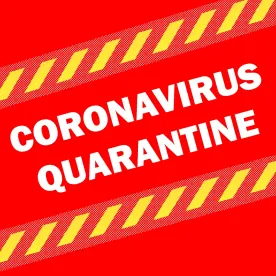This morning Governor Evers declared on Twitter he would be issuing a “safer-at-home” order on Tuesday, otherwise known as a shelter-in-place order. He noted “[t]here will be additional details soon about what this order means for you, but I wanted to give everyone the opportunity to prepare and plan ahead so you can help do your part to keep our friends, neighbors, and communities safe.”
The order will presumably replace the previously issued Department of Health Services (“DHS”) Emergency Order #8, which limited “mass gatherings” to 10 individuals or more but included numerous exemptions. Order #8 was previously summarized in this Legal Update.
The way in which the Governor defines “essential services” will be key for businesses, local units of government, and industry leaders to understand to determine whether the definition applies to their organization, thereby allowing it to continue to publicly operate during the pendency of the declared public health emergency. The Governor already tweeted “[w]orkers providing essential care or services in our communities will be allowed to continue to travel to and from work. That includes folks like healthcare professionals, grocers, family caregivers, among other people whose work is critical for folks across our state.” Our previous Legal Update provided direction to manufacturers attempting to determine how their operations may be impacted.
It is possible, although not guaranteed, the way in which the Governor defines “essential services” tracks the exemptions to DHS Emergency Order #8. Additionally, the Governor may rely on a recently issued Department of Homeland Security report for further guidance as to which services should be considered “essential.” The guidance included in the Homeland Security report is summarized below as well.
“Safer-at-Home” Order
While the text of the order will not be available until tomorrow, the Governor issued a series of tweets that reveal the core elements of the forthcoming order:
-
“Over the past few days, I’ve talked with public health experts and with business leaders and local elected officials around the state. Overwhelmingly the response I heard is that we need an all-hands-on-deck approach to stopping the spread of COVID-19 in Wisconsin. In fact, business leaders have suggested it is imperative to slow the growth of the disease and that the state cease all non-essential business statewide.”
-
“I know that has been difficult and has disrupted the lives of people across our state. That’s why issuing a #SaferAtHome order isn’t something I thought we’d have to do, and it’s not something I take lightly. But here’s the bottom line: folks need to start taking this seriously.”
-
“We also need folks to limit their interactions to the same people, not different small groups. Shrinking your circle of interactions will help prevent the spread of COVID-19. Unfortunately that means no sleepovers, no play dates, and no dinner parties with friends and neighbors.”
-
“We’re all in this together, and each and every one of us has to do our part to help slow the spread of COVID-19 so we can #FlattenTheCurve to ensure our doctors, nurses, and healthcare workers have the opportunity to do their important work.”
-
“You can still get out and walk the dogs – it’s good exercise and it’s good for everyone’s mental health – but please don’t take any other unnecessary trips, and limit your travel to essential needs like going to the doctor, grabbing groceries, or getting medication.”
-
“Workers providing essential care or services in our communities will be allowed to continue to travel to and from work. That includes folks like healthcare professionals, grocers, family caregivers, among other people whose work is critical for folks across our state.”
-
“If it’s essential for you to go outside, please stay 6 feet away from others and shared spaces such as park shelters and visitor centers.”
The complete thread can be found here.
Department of Homeland Security Cybersecurity and Infrastructure Agency (“CISA”) Guidance
Like the Governor’s previous emergency orders, shelter-in-place orders are issued at the state level and, therefore, the contents of shelter-in-place orders will vary from state to state. Illinois, California, and New York have already issued such orders.
Typically, shelter-in-place orders will restrict people from all “unnecessary” gatherings. This generally means that residents are only permitted to leave their homes to go to grocery stores, pharmacies, or gas stations, and to take walks outside, so long as they follow social distance measures. However, businesses and other operations essential to the economy and public health and safety are permitted and/or required to remain operational and open for business. What is “essential” must be determined directly by the Governor and set forth in such an order, left to the decision of local governments, or a combination thereof.
While what is “essential” is left to the discretion of individual states, the Department of Homeland Security Cybersecurity and Infrastructure Agency (“CISA”) has issued guidance to assist states in determining essential critical infrastructure workforce. Importantly, CISA’s guidance is not binding and is merely advisory. However, CISA offers guidance and assistance to state and local governments because “[p]romoting the ability of such workers to continue to work during periods of community restriction, access management, social distancing, or closure orders/directives is crucial to community resilience and continuity of essential functions.”
According to CISA, “Essential Critical Infrastructure Sectors” include:
-
Healthcare/Public Health
-
Law Enforcement, Public Safety, First Responders
-
Food and Agriculture
-
Energy
-
Water and Wastewater
-
Transportation and Logistics
-
Public Works
-
Communications and IT
-
Other community-based government operations and essential functions
-
Critical Manufacturing
-
Hazardous Materials
-
Financial Services
-
Chemical
-
Defense Industrial Base
Even though CISA recommends that such industries remain open and operational for the duration of the COVID-19 public health emergency, CISA recommends that employees work remotely whenever possible, follow guidance from the CDC, as well as state and local government officials, regarding strategies to limit disease spread, and to follow or put in place business continuity and pandemic plans.



 />i
/>i


